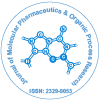Nanostructured Lipid Carriers for Enhanced Oral Delivery of Poorly Soluble Drugs: Formulation, Characterization, and Pharmacokinetic Study
Received: 01-Jan-2024 / Manuscript No. JMPOPR-25-168296 / Editor assigned: 03-Jan-2024 / PreQC No. JMPOPR-25-168296(PQ) / Reviewed: 17-Jan-2024 / QC No. JMPOPR-25-168296 / Revised: 22-Jan-2024 / Manuscript No. JMPOPR-25-168296(R) / Published Date: 29-Jan-2024
Abstract
The oral bioavailability of poorly water-soluble drugs remains a significant barrier in modern drug development. Nanostructured lipid carriers (NLCs) have emerged as an effective platform to enhance drug solubility, stability, and gastrointestinal absorption. This study presents the development and evaluation of curcumin-loaded NLCs prepared via hot homogenization followed by ultrasonication. The formulation was characterized for particle size, zeta potential, encapsulation efficiency, in vitro release, and pharmacokinetics in Wistar rats. The results showed that the NLCs significantly improved the solubility and systemic availability of curcumin compared to pure drug suspension, offering a potential approach for the oral delivery of lipophilic drugs.
Keywords
Nanostructured lipid carriers; Curcumin; Oral delivery; Lipid nanoparticles; Bioavailability; Pharmacokinetics; Solubility enhancement; Molecular pharmaceutics; Encapsulation; Drug release
Introduction
Oral administration remains the most preferred route of drug delivery due to its non-invasiveness and patient compliance. However, a major limitation arises when dealing with drugs that exhibit poor aqueous solubility, leading to inadequate absorption and bioavailability. This challenge is especially relevant for drugs classified under Biopharmaceutics Classification System (BCS) Class II and IV [1]. Curcumin, a hydrophobic polyphenol derived from Curcuma longa, has demonstrated potent antioxidant, anti-inflammatory, and anticancer activities in vitro but suffers from poor oral bioavailability due to low solubility and rapid systemic elimination [2][3].
Recent advances in lipid-based delivery systems have highlighted NLCs as versatile carriers for lipophilic drugs. NLCs are second-generation lipid nanoparticles composed of a blend of solid and liquid lipids, designed to overcome the limitations of solid lipid nanoparticles (SLNs) such as drug expulsion during storage and limited payload [4]. Their unique structure offers improved drug entrapment, controlled release, and better physicochemical stability [5]. The objective of this study is to formulate curcumin-loaded NLCs, optimize their physicochemical properties, and evaluate their pharmacokinetic performance in vivo.
Materials and Methods
Curcumin was procured from Sigma-Aldrich. The lipid phase comprised glyceryl monostearate (solid lipid) and Capryol 90 (liquid lipid), while the aqueous phase contained Poloxamer 188 and soy lecithin as stabilizers. NLCs were prepared using a hot homogenization technique followed by probe ultrasonication. The lipid mixture was heated to 80°C and dissolved with curcumin, followed by emulsification with the pre-heated aqueous phase under high-speed homogenization (15,000 rpm for 5 minutes) and ultrasonication (5 minutes, 50% amplitude).
Particle size and zeta potential were measured using dynamic light scattering (Malvern Zetasizer Nano ZS). Encapsulation efficiency was calculated after ultracentrifugation and UV-Vis spectrophotometric analysis at 420 nm. In vitro release studies were conducted in simulated gastric (pH 1.2) and intestinal (pH 6.8) fluids using the dialysis bag method over 24 hours. Pharmacokinetic studies were conducted in male Wistar rats (n=6 per group) administered a single oral dose of NLCs or curcumin suspension (50 mg/kg), with plasma drug levels determined by HPLC.
Results
The optimized curcumin-NLCs exhibited a mean particle size of 155.2 ± 4.6 nm, polydispersity index of 0.231 ± 0.02, and a zeta potential of –26.8 ± 2.3 mV, indicating good colloidal stability [6]. Encapsulation efficiency was 87.5 ± 1.8%, reflecting high drug entrapment within the lipid matrix. The in vitro release profile revealed a biphasic pattern: an initial burst (20% within 2 hours) followed by sustained release up to 24 hours (84% cumulative release).
Pharmacokinetic results demonstrated significant improvement in systemic exposure. The C_max of curcumin from NLCs was 2.48 ± 0.35 µg/mL, approximately 3.5 times higher than the pure drug suspension (0.71 ± 0.22 µg/mL). The AUC_0–∞ value increased by over 4-fold (22.34 ± 2.5 µg·h/mL vs. 5.28 ± 1.3 µg·h/mL), indicating enhanced absorption [7]. Relative bioavailability was calculated to be 421%.
Discussion
The findings support the hypothesis that nanostructured lipid carriers can significantly enhance the oral bioavailability of poorly soluble drugs such as curcumin. The small particle size enhances surface area and dissolution rate, while the negative zeta potential contributes to stability and mucosal interaction [8]. High encapsulation efficiency indicates optimal compatibility between curcumin and the lipid matrix. The sustained release profile reduces dosing frequency and potentially improves patient adherence.
Improved pharmacokinetic parameters suggest that lipid-based nanocarriers bypass first-pass metabolism and improve lymphatic uptake [9]. The results are in agreement with previous studies reporting enhanced bioavailability of lipophilic drugs through NLC-based systems [10]. Overall, the use of NLCs represents a promising avenue for the oral delivery of hydrophobic therapeutics.
Conclusion
This study demonstrates that nanostructured lipid carriers are a viable strategy to improve the oral bioavailability of curcumin. The optimized NLC formulation exhibited favorable physicochemical properties and significantly enhanced pharmacokinetic performance in vivo. These findings underscore the potential of NLCs in molecular pharmaceutics, particularly for delivering poorly water-soluble drugs via the oral route.
Citation: Priya SM (2025) Nanostructured Lipid Carriers for Enhanced Oral Deliveryof Poorly Soluble Drugs: Formulation, Characterization, and PharmacokineticStudy. J Mol Pharm Org Process Res 13: 273.
Copyright: 穢 2025 Priya SM. This is an open-access article distributed under theterms of the Creative Commons Attribution License, which permits unrestricteduse, distribution, and reproduction in any medium, provided the original author andsource are credited.
Select your language of interest to view the total content in your interested language
Share This Article
Recommended Journals
91勛圖 Journals
Article Usage
- Total views: 92
- [From(publication date): 0-0 - Aug 31, 2025]
- Breakdown by view type
- HTML page views: 64
- PDF downloads: 28
